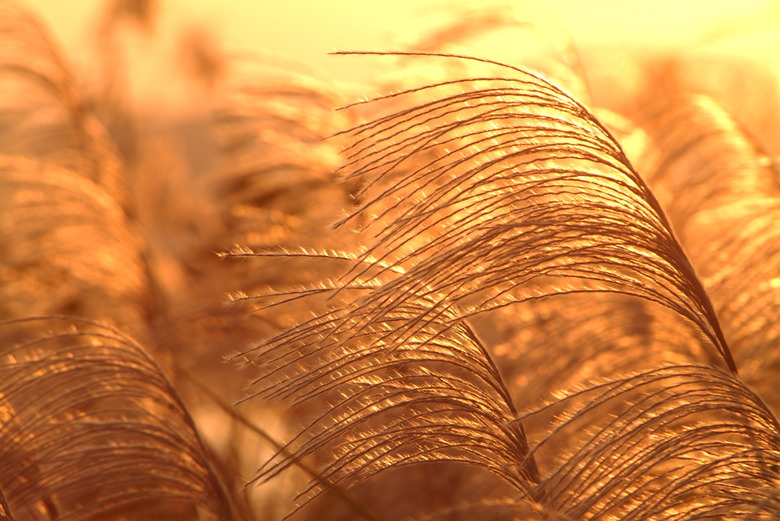Short Ornamental Grasses
Short ornamental grasses deserve a place in every garden. Tolerating a range of growing conditions, according to the variety, these low-maintenance plants offer color, flowers and interesting textures without overshadowing other plants or stealing the limelight. Select cultivars that are hardy in your local U.S. Department of Agriculture plant hardiness zones and that thrive in the existing growing conditions, for the best results.
None of the following grasses are invasive.
Sunny Spots
Many short ornamental grasses thrive in full-sun areas, which receive at least six hours of direct sunlight every day.
Tufted fescue 'Klose' (Festuca amethystina 'Klose') provides bluish-green foliage in spring, which matures to olive green. In late spring, purple-tinged, light green flowers appear. 'Klose' is hardy in USDA zones 4 through 8 and usually grows 8 inches tall, but its flowers may grow 18 inches tall. Growing in clumps 9 to 12 inches wide, 'Klose' leaves are erect or arching and needlelike. Wheat grass 'Blue Tango' (Elymus magellanicus 'Blue Tango') offers narrow, sharply pointed, gray-blue grass blades that grow in tufts 9 to 12 inches tall and wide. Bluish-green flower spikes appear late spring through early summer, followed by tan seed heads. 'Blue Tango' is hardy in USDA zones 5 through 8.
Dry Soil
Drought tolerance is a common characteristic of ornamental grasses, which can also offer decorative features.
Silver hair grass (Koeleria argentea) grows well in full sun and dry soil. Hardy in USDA zones 6 through 9, silver hair grass grows in dense tufts of thin grass 12 to 18 inches tall and wide. The undersides of the grass blades are silvery, giving a silver-green two-toned effect.
Blue fescue 'Elijah Blue' (Festuca glauca 'Elijah Blue') grows 9 to 12 inches tall and 6 to 12 inches wide and provides fine-textured, silver-blue foliage. 'Elijah Blue' also features purple-tinged, light green flowers late spring through early summer, followed by buff seedheads. Hardy in USDA zones 4 through 8, this grass is semievergreen and prefers to grow in sunny spots.
Shady Sites
Short ornamental grasses that tolerate partial shade provide an alternative in shady areas where lawn grasses often fail to thrive. Partial-shade growing spots receive four to six hours of direct sunlight per day.
Quaking grass (_Briza media_) grows 12 to 18 inches tall and blooms spring through summer. Spikelets of purple blooms rise above the foliage on delicate stems that vibrate in the breeze. Hardy in USDA zones 4 through 10, quaking grass grow in full-sun and partially shaded sites. Blue moor grass (_Sesleria caerulea_) is named for its narrow, twisted, blue-tinted green leaves, which grow in loose tufts 6 to 12 inches tall and 9 to 12 inches wide. Greenish flowers appear on narrow spikes in spring and turn silvery over time. Blue moor grass is hardy in USDA zones 5 through 8.
Moist Soil
Ornamental grasses that thrive in moist soil can grow next to ponds or streams and in other wet areas of the garden.
Japanese forest grass (_Hakonechloa macra_), which is hardy in USDA zones 5 through 9, grows 12 to 18 inches tall and 12 to 24 inches wide. Providing arching, bright green, papery leaves, Japanese forest grass grows well in moist soil and partially shaded sites, and it tolerates as little as two hours of direct sunlight per day.
Tufted hair grass 'Northern Lights' (Deschampsia caespitosa 'Northern Lights') features variegated green and creamy white foliage that emerges flushed rosy pink in spring. Buff-colored blooms appear in summer, and the rose-pink blush returns to the leaves in fall. Growing up to 12 inches tall and wide, 'Northern Lights' is hardy in USDA zones 4 through 9 and grows best in filtered sun.
Flowering Ornamental Grasses
Consider the mature size of the plant before choosing a flowering ornamental grass. Flower color varies depending on the cultivar. Switchgrass grows to heights of 2 to 8 feet, with a spread of 2 to 4 feet. Pink muhly grass (Muhlenbergia capillaris) also prefers sunny areas of the garden. The flowing foliage adds contrast to brightly colored flowers and a sense of softness to the landscape as it sways in the breeze. Many types of ornamental grasses develop deep root systems that make them fairly drought tolerant once they are established, the National Gardening Association notes. Divide grasses every three to four years in early fall or early spring, depending on the grass.
- Tufted hair grass 'Northern Lights' (Deschampsia caespitosa 'Northern Lights' features variegated green and creamy white foliage that emerges flushed rosy pink in spring.
- Pink muhly grass (Muhlenbergia capillaris) also prefers sunny areas of the garden.
Tip
Silver hair grass and 'Elijah Blue' also tolerate air pollution and shallow, rocky soil.
